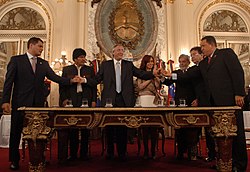Bank of the South
The Bank of the South (Spanish: Banco del Sur, Portuguese: Banco do Sul, Dutch: Bank van het Zuiden) or BancoSur is a monetary fund and lending organization established on 26 September 2009 by Argentina, Brazil, Paraguay, Uruguay, Ecuador, Bolivia and Venezuela with promises of initial capital of US$20 billion.
Argentina, Venezuela, and Brazil were to have each pledged $4 billion, and Uruguay, Ecuador, Paraguay and Bolivia were to have contributed smaller amounts.
It has been established because of disapproval of the protocol of the World Bank and International Monetary Fund (IMF), in particular the enforcement of unrelated free market reforms on countries seeking emergency loans.
[9][10][11] The concept was originally launched in 2006 in a cooperation between Venezuela and Argentina, led by their respective Presidents Hugo Chávez and Néstor Kirchner.
[12] In May 2007, a meeting in Quito led to the official creation of the bank, and was said to indisputably signify another step towards Latin American integration.
[16] On 26 September 2009, the presidents of Argentina, Brazil, Paraguay, Uruguay, Ecuador, Bolivia and Venezuela signed an agreement establishing the South Bank with an initial capital of US$20 billion.
Leaders including Brazilian President Luiz Inácio Lula da Silva and Argentina's Cristina Fernández de Kirchner formally signed up to the pact and announced that the starting capital would be US$20 billion.
[18] In 2010, Americas Quarterly wrote that "Banco del Sur will have a negative effect on the region’s development and credit worthiness and dearly cost its members", saying that supporters of the bank's independence from international markets only use "rhetoric arguments" to defend the initiative, summarizing the effort as "another example of the populist ambition and misguided policies that have taken hold again in the region.
